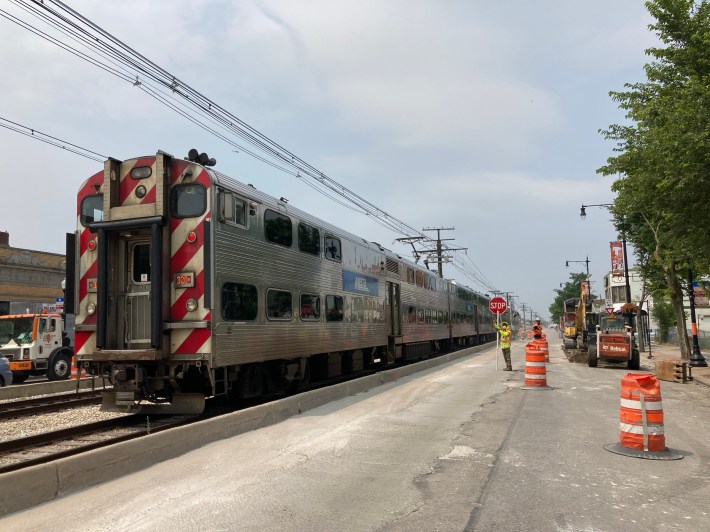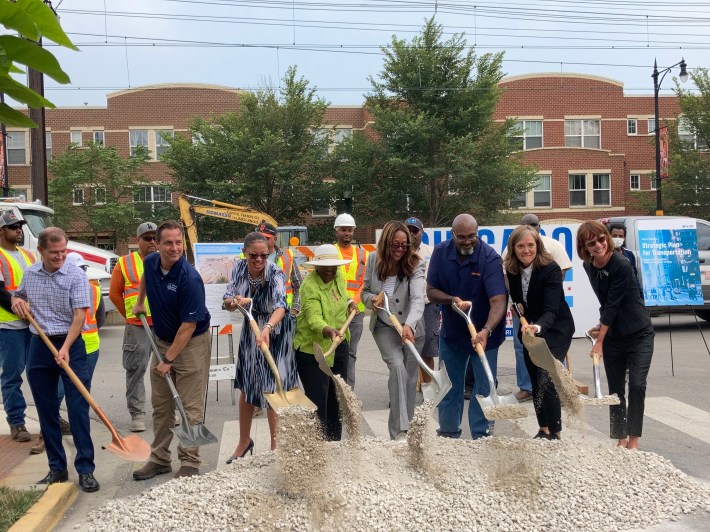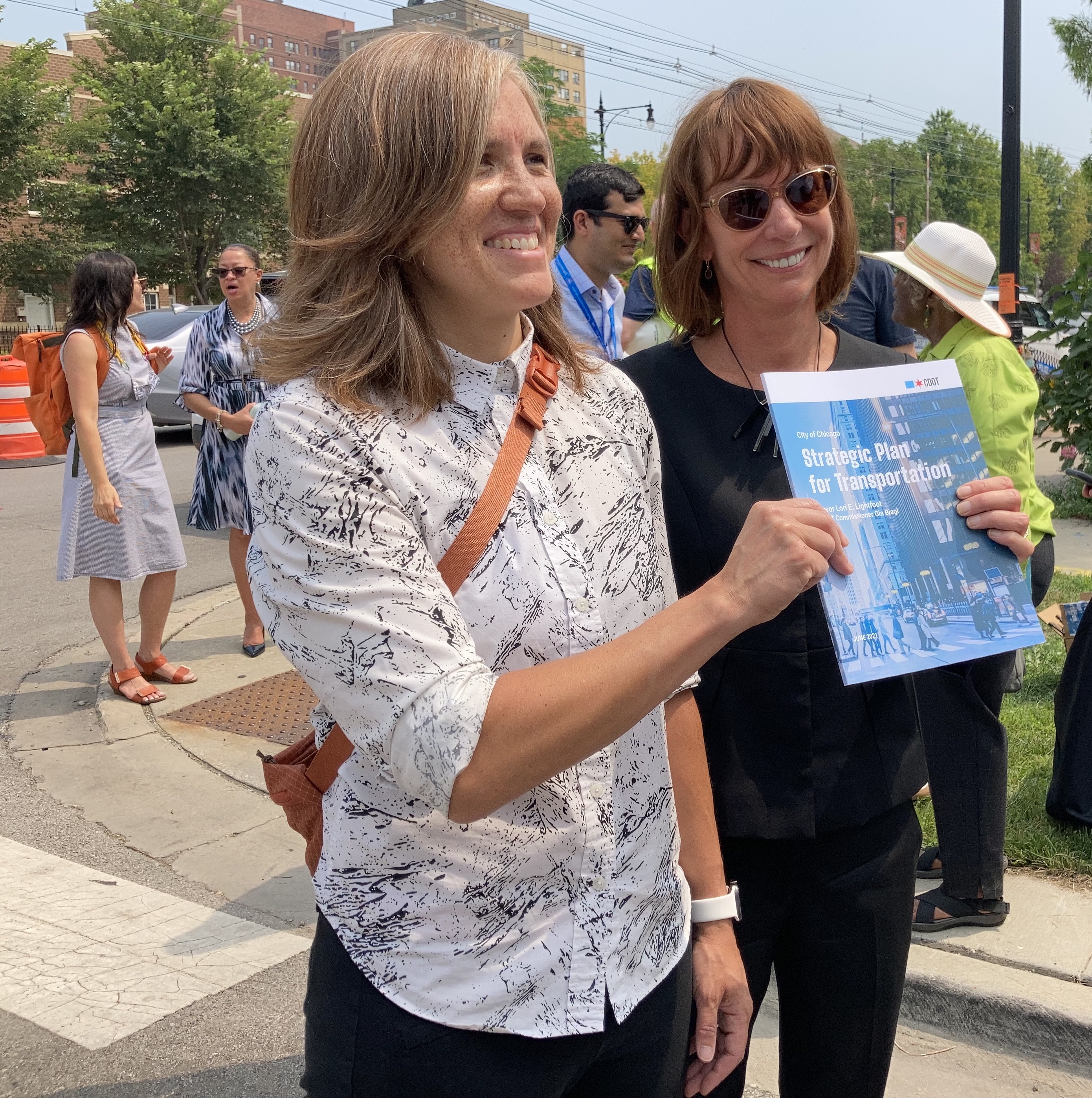Today at the groundbreaking for the 71st Street streetscaping project in South Shore, Chicago Department of Transportation commissioner Gia Biagi announced the release of the city's new Strategic Plan for Transportation. Chicago officials are calling the document the nation’s first urban transportation plan developed in the wake of the COVID-19 pandemic and last year's racial justice and economic crises, and say the plan will help promote social equity and public safety. The plan is intended to complement Mayor Lori Lightfoot’s five-year, multi-billion-dollar Chicago Works infrastructure plan.
"In order for our transportation network to truly work for our city, it must serve all of our residents equitably," Lightfoot, who didn't attend the event, said in a statement. "This strategic plan, developed in the midst of the pandemic, highlights our commitment to do just that, as it will help lower the economic and environmental burden of transportation on our residents and prioritize investments in underserved communities."
The 79-page document includes 84 strategies and hundreds of one-to-three-year targets that CDOT says will help build safer streets; prioritize improving transportation options for residents in low-income communities; expand transit access; and provide bus lanes, bikeways, and bike-share across the entire city. Goals include (language is CDOT's):
Aligning Our Streets with Our Values:
- Establish a citywide truck route network
- Complete the Smart Lighting Upgrade of 270,000 streetlights and reduce street lighting energy consumption by 50 percent
- Develop new metrics to evaluate and execute projects based on equity, safety, and condition
Access to Opportunity:
- Establish a traffic management center to respond to changing traffic conditions, and modernize traffic signals
- Deepen partnerships with CTA, Metra and Pace to expand transit access; make tactical improvements to high ridership bus routes; identify and implement rapid bus corridors
- Complete the Divvy expansion to cover the entire city, including more than 200 new Divvy stations in 2021 on the southwest and northwest sides; reach 16,500 Divvy bikes by 2023
Streets Free from Violence
- Invest in strategies, programs, and infrastructure to reduce all forms of violence in our communities while recognizing the need to address trauma from past violence and to help increase walking and cycling in predominantly Black and Brown communities.
- Extend Vision Zero farther into city policies, establish safer speed limits, and improve driver safety education
- Expand the Slow Streets, Café Streets, and Make Way for People programs
- Expand the Community Greening program and make it easier for Chicago communities to activate their streets
The plan was written with input from the Transportation Equity Network, a coalition of community groups and transportation advocacy organizations, including the Center for Neighborhood Technology, the Active Transportation Alliance, and the mobility justice nonprofit Equiticity. It's hard to say if that group's contributions rise to the level of community engagement that should occur to create a strategic plan.
According to city officials, CDOT and CNT are working on a process to identify communities with the greatest economic and mobility challenges, so that these neighborhoods can be prioritized for transportation upgrades.

During the groundbreaking Biagi noted, "We've made it through a difficult year and have to come back stronger." She promised that the plan will lead to transportation projects that "center equity," with "more transparency and and accountability," and which will help to "break the cycle of intergenerational poverty in underserved communities by connecting residents with educational and job opportunities. The commissioner also committed to a new emphasis on community input. "Some of the best expertise comes from the block."
Biagi added that CDOT is committed to "doing our part to make streets free of violence of all kinds." She asked community members to "hold our feet to the fire... hold us accountable for carrying out the plan."
Jacky Grimshaw, vice president for government affairs said at the event, "The plan is a great start for setting a new direction." She argued that if the transportation follows through on its goals, it will "improve transportation equity across the city and help to repair past and ongoing harms of transportation decisions especially in Black and Brown communities."
Former New York City transportation chief Janette Sadik-Khan, who oversaw bold transportation changes in that city, such as the pedestrianization of Broadway and Times Square and the launch of the Select express bus system, now works at Bloomberg Associates, which helped CDOT write the plan. At the groundbreaking, Sadik-Khan said, "We owe a just recovery to city residents," especially essential workers who were required to show up to work in person during the pandemic. "In the post-pandemic era, transportation as usual just isn't good enough." She promised that the document will help create a Chicago that's "less dependent on car ownership," although she conceded that following through to create a less auto-centric city won't be easy. "It's always a fight to change the direction of streets."

After the participants tossed the first shovels of dirt to kick of the streetscape project, Sadik-Khan told me this was actually her first time meeting most of the people involved with the plan in person, since most of the collaboration was done during the pandemic over Zoom. She noted that, compared to NYC, "the streets are generally wider here, so there's a lot of opportunity to reimagine streets to make them better for walking, biking, and transit."
I noted that the city of Chicago previously tried to launch robust bus rapid transit on Ashland Avenue, only to have the project killed due to backlash from some residents and merchants to converting mixed-traffic lanes to bus lanes. I added that, unlike the Select system, Chicago's Loop Link downtown express bus corridor was watered down, with no prepaid boarding or camera-enforced bus lanes. I asked Sadik-Khan why Chicago is any more likely to get fast bus service under the new plan.
"There are detailed strategies with benchmarks," she responded. "It's more than just a promise; it's a detailed blueprint for getting it done."
Commissioner Biagi, who joined our conversation, added, "It's a living document. If we're not hitting the benchmarks, let's figure out how to hit the benchmarks. I expect you to read it closely and say, 'Commissioner, a year has gone by – why haven't you accomplished this goal?'"
During the last decade, we've seen a number of of CDOT plans that only saw a fraction of the strategies actually implemented, including the Chicago Forward Plan, the CDOT Pedestrian Plan, the Streets for Cycling Plan 2020, and the Vision Zero Chicago plan. Here's hoping that the Strategic Plan for Transportation will be different.
Streetsblog Chicago will run a closer analysis of the document in the near future. Read it here.





